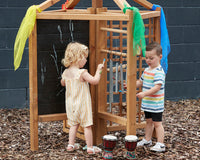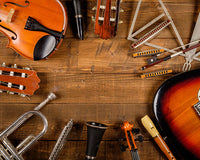To keep your instrument in good condition, you need to take care of it correctly. We have put together this brief guide of hints and tips to help you. You can
download the PDF version of this guide here.
Assembly
- Push the bell joint onto the lower joint. (This may need grease if very stiff)
-
Twist and push this on. Try not to hold the keys as these bend easily!
- To join the two key joints, lift the key that links the two joints together (on the top joint which sticks down below the joint) and slowly push and twist the two joints together.
- Make sure the key that links the two joints does not get caught as this can cause several problems (if in doubt at this stage, consult your teacher for advice).
- Twist the barrel onto the top joint.
- You then place the reed onto the mouthpiece (flat side inwards) and attach this using the ligature (as in picture above) - Watch the video on how to put a reed on a clarinet mouthpiece.
- Put the mouthpiece on top of the barrel - this is now ready to play.
- To disassemble, repeat above but backwards.
Every Usage
- Ensure no food, sweets or sugary drinks are consumed just before or during play. This can leave a residue inside the instrument and is usually the cause of ‘sticky’ pads.
- Use a pull through after every use. This helps to dry the pads and keep them at optimum condition. Do not store this inside the clarinet case as the moisture will get back into the clarinet
- Wipe the keys down after play with a silver cloth. Sweat can cause issues to plating if this is not cleaned sufficiently.
- After playing, remove the reed from the instrument and put back into the cover to dry out. This will ensure that the reed doesn’t warp. If the reed becomes chipped/split it is unlikely to work and will need replacing. The life of a reed is solely dependent on how well it is looked after.
- Check that the cork is greased enough. Not enough will make this difficult to assemble, too much and this will not stay in position.
-
Check the instrument over. If something looks out of place, ask the teacher to have a look at it.
Common Clarinet Problems
-
Bent Keys - Clarinet keys can get bent very easily. As they are made from such a soft metal, extra care is needed when assembling and taking the clarinet apart. PLEASE NOTE, BENT KEYS ARE NOT COVERED UNDER WARRANTY
-
Sticky Pads - Another common problem is a key getting stuck. This tends to be because the pads are dirty and need a clean up. Put a piece of cigarette paper under the key, close the key and gently pull the paper out from under the key. This should remove any residue that is on the keys. If in doubt, take this to the teacher to look at or get in touch with our technician for advice.
For optimum results, we recommend buying the below items for your instrument. This will help to keep the instrument in the best possible condition.
 Rico Clarinet Reeds
Rico Clarinet Reeds These reeds are available in various strengths (most children start on 1 1/2). If you play the mini clarinet, you will need
Eb Clarinet reeds.
 Clarinet Pull Through
Clarinet Pull Through This cloth with a weighted chord makes it easy to clean our your clarinet. You must to this regularly to keep your instrument in top condition.
 Cork Grease
Cork Grease Apply to the cork on your instrument joints for easier assembly. It ensures your clarinet keywork does not get damaged by forcing the clarinet together. We sell a
complete care kit containing all the tools you need to keep your instrument in great condition.
 Rico Clarinet Reeds These reeds are available in various strengths (most children start on 1 1/2). If you play the mini clarinet, you will need Eb Clarinet reeds.
Rico Clarinet Reeds These reeds are available in various strengths (most children start on 1 1/2). If you play the mini clarinet, you will need Eb Clarinet reeds.  Clarinet Pull Through This cloth with a weighted chord makes it easy to clean our your clarinet. You must to this regularly to keep your instrument in top condition.
Clarinet Pull Through This cloth with a weighted chord makes it easy to clean our your clarinet. You must to this regularly to keep your instrument in top condition.  Cork Grease Apply to the cork on your instrument joints for easier assembly. It ensures your clarinet keywork does not get damaged by forcing the clarinet together. We sell a complete care kit containing all the tools you need to keep your instrument in great condition.
Cork Grease Apply to the cork on your instrument joints for easier assembly. It ensures your clarinet keywork does not get damaged by forcing the clarinet together. We sell a complete care kit containing all the tools you need to keep your instrument in great condition.




















